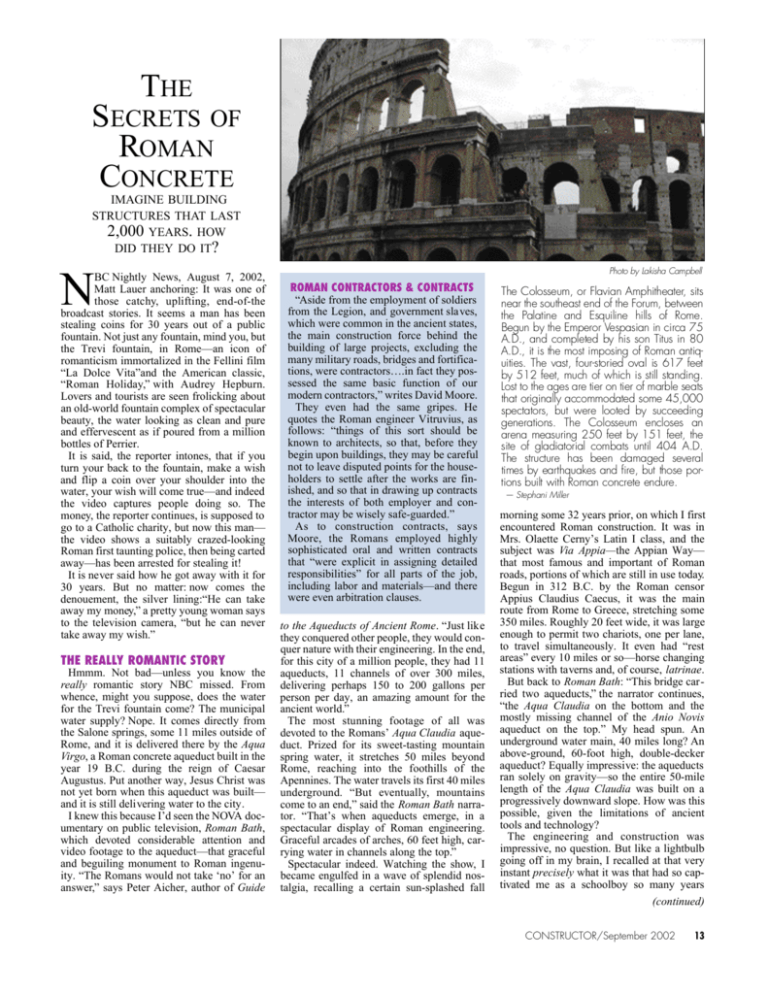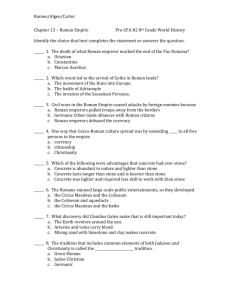THE SECRETS OF ROMAN CONCRETE
advertisement

THE SECRETS OF ROMAN CONCRETE IMAGINE BUILDING STRUCTURES THAT LAST 2,000 YEARS. HOW DID THEY DO IT? N BC Nightly News, August 7, 2002, Matt Lauer anchoring: It was one of those catchy, uplifting, end-of-the broadcast stories. It seems a man has been stealing coins for 30 years out of a public fountain. Not just any fountain, mind you, but the Trevi fountain, in Rome—an icon of romanticism immortalized in the Fellini film “La Dolce Vita”and the American classic, “Roman Holiday,” with Audrey Hepburn. Lovers and tourists are seen frolicking about an old-world fountain complex of spectacular beauty, the water looking as clean and pure and effervescent as if poured from a million bottles of Perrier. It is said, the reporter intones, that if you turn your back to the fountain, make a wish and flip a coin over your shoulder into the water, your wish will come true—and indeed the video captures people doing so. The money, the reporter continues, is supposed to go to a Catholic charity, but now this man— the video shows a suitably crazed-looking Roman first taunting police, then being carted away—has been arrested for stealing it! It is never said how he got away with it for 30 years. But no matter: now comes the denouement, the silver lining:“He can take away my money,” a pretty young woman says to the television camera, “but he can never take away my wish.” THE REALLY ROMANTIC STORY Hmmm. Not bad—unless you know the really romantic story NBC missed. From whence, might you suppose, does the water for the Trevi fountain come? The municipal water supply? Nope. It comes directly from the Salone springs, some 11 miles outside of Rome, and it is delivered there by the Aqua Virgo, a Roman concrete aqueduct built in the year 19 B.C. during the reign of Caesar Augustus. Put another way, Jesus Christ was not yet born when this aqueduct was built— and it is still delivering water to the city. I knew this because I’d seen the NOVA documentary on public television, Roman Bath, which devoted considerable attention and video footage to the aqueduct—that graceful and beguiling monument to Roman ingenuity. “The Romans would not take ‘no’ for an answer,” says Peter Aicher, author of Guide Photo by Lakisha Campbell ROMAN CONTRACTORS & CONTRACTS “Aside from the employment of soldiers from the Legion, and government slaves, which were common in the ancient states, the main construction force behind the building of large projects, excluding the many military roads, bridges and fortifications, were contractors….in fact they possessed the same basic function of our modern contractors,” writes David Moore. They even had the same gripes. He quotes the Roman engineer Vitruvius, as follows: “things of this sort should be known to architects, so that, before they begin upon buildings, they may be careful not to leave disputed points for the householders to settle after the works are finished, and so that in drawing up contracts the interests of both employer and contractor may be wisely safe-guarded.” As to construction contracts, says Moore, the Romans employed highly sophisticated oral and written contracts that “were explicit in assigning detailed responsibilities” for all parts of the job, including labor and materials—and there were even arbitration clauses. to the Aqueducts of Ancient Rome. “Just like they conquered other people, they would conquer nature with their engineering. In the end, for this city of a million people, they had 11 aqueducts, 11 channels of over 300 miles, delivering perhaps 150 to 200 gallons per person per day, an amazing amount for the ancient world.” The most stunning footage of all was devoted to the Romans’ Aqua Claudia aqueduct. Prized for its sweet-tasting mountain spring water, it stretches 50 miles beyond Rome, reaching into the foothills of the Apennines. The water travels its first 40 miles underground. “But eventually, mountains come to an end,” said the Roman Bath narrator. “That’s when aqueducts emerge, in a spectacular display of Roman engineering. Graceful arcades of arches, 60 feet high, carrying water in channels along the top.” Spectacular indeed. Watching the show, I became engulfed in a wave of splendid nostalgia, recalling a certain sun-splashed fall The Colosseum, or Flavian Amphitheater, sits near the southeast end of the Forum, between the Palatine and Esquiline hills of Rome. Begun by the Emperor Vespasian in circa 75 A.D., and completed by his son Titus in 80 A.D., it is the most imposing of Roman antiquities. The vast, four-storied oval is 617 feet by 512 feet, much of which is still standing. Lost to the ages are tier on tier of marble seats that originally accommodated some 45,000 spectators, but were looted by succeeding generations. The Colosseum encloses an arena measuring 250 feet by 151 feet, the site of gladiatorial combats until 404 A.D. The structure has been damaged several times by earthquakes and fire, but those portions built with Roman concrete endure. — Stephani Miller morning some 32 years prior, on which I first encountered Roman construction. It was in Mrs. Olaette Cerny’s Latin I class, and the subject was Via Appia—the Appian Way— that most famous and important of Roman roads, portions of which are still in use today. Begun in 312 B.C. by the Roman censor Appius Claudius Caecus, it was the main route from Rome to Greece, stretching some 350 miles. Roughly 20 feet wide, it was large enough to permit two chariots, one per lane, to travel simultaneously. It even had “rest areas” every 10 miles or so—horse changing stations with taverns and, of course, latrinae. But back to Roman Bath: “This bridge carried two aqueducts,” the narrator continues, “the Aqua Claudia on the bottom and the mostly missing channel of the Anio Novis aqueduct on the top.” My head spun. An underground water main, 40 miles long? An above-ground, 60-foot high, double-decker aqueduct? Equally impressive: the aqueducts ran solely on gravity—so the entire 50-mile length of the Aqua Claudia was built on a progressively downward slope. How was this possible, given the limitations of ancient tools and technology? The engineering and construction was impressive, no question. But like a lightbulb going off in my brain, I recalled at that very instant precisely what it was that had so captivated me as a schoolboy so many years (continued) CONSTRUCTOR/September 2002 13 SECRETS SECRETS SECRETS ROMAN LABORERS & GUILDPERSONS The Roman construction labor force consisted of slaves, freedmen, poor citizens, soldiers from the Legions, and skilled labor—guild persons—Moore writes. “It was the guilds that provided the skilled labor needed to fasten timber pieces into the scaffolding trusswork that spanned large openings in the construction of arches and domes. They also provided the metal work and other refinements of the structures.” The guilds were not collective bargaining devices but almost akin to distinct social classes much like the caste system of India. Once born into a guild, you picked up the trade and practiced it throughout your lifetime. Guilds had their own meeting halls and even their own goddess, Minerva—the deity of handiwork. Numa, the early second Roman king, organized the following guilds: flute-players, goldsmiths, dryers, cobblers, tanners, copper workers, potters, and carpenters. Other known guilds included metal workers, for both bronze and iron; brick and cement masons; timber workers; wagoners; and wreckers. before: concrete. How in the heck did the Romans make it to last 2,000 years? What was different about their methods—and what can we learn from them? Long ago, I realized, I had tied a string around my finger. It was still there. USED BY PATTON’S ARMIES The aqueducts, I knew, were just one example of Roman concrete. In World War II, U.S. Army Gen. George S. Patton, a celebrated mystic who believed himself to be a reincarnated ancient warrior, took great satisfaction in directing the Seventh and later the Third army over bridges used by Julius Caesar, Sulla, Pompey, and other Roman commanders. From the Colosseum, to the Pantheon, to the Arch of Constantine, to numerous sites in Rome, to the ruins of Pompeii and Roman estates, throughout much of the Mediterranean basin, northward to Britain and throughout much of Europe, there are literally thousands of Roman concrete works still with us today. Many of them are crumbling, but quite a few, like the Pons Fabricius bridge in Rome, connecting the left bank of the Tiber river to Tiber Island, are structurally sound and still in use. Newly inspired, I hopped on my computer, logged onto Amazon.com, and typed the words “Roman Concrete” into the search engine. Somebody, surely, the scientists— they must have figured it all out long ago. But nothing came up. Next I logged onto Yahoo.com, typed the same words into the browser, and bingo: 88,000 references. Most of what I found, however, was either sketchy, boilerplate, repetitive, or anecdotal. Certainly there were some tantalizing snippets, university postings in particular, but nothing comprehensive, not one discrete publication wholly devoted to Roman concrete. I did unearth one shiny nugget, however: an intriguing website, www.romanconcrete.com, which in turn touted a book, The Roman Pan theon—The Triumph of Concrete, written by David Moore, P.E. THE DEFINITIVE STUDY Soon I was on the horn talking with Moore, a most courtly and agreeable gentleman, who volunteered to send a copy. When it arrived, I found to my great satisfaction that the title was misleading. Although it begins with an exploration of the Pantheon in voluptuous detail, the overwhelming bulk of this 239page masterpiece, richly detailed and exquisitely footnoted, comprises the definitive study of Roman concrete—who, where, when, what, why, and how. Moore draws heavily on ancient Roman sources, quoting extensively the five authors whose writings on concrete remain—Cato the Censor, Marcus Vitruvius Pollio, Pliny the Elder, Statius the Poet, and the Emperor Julian. He also presents a rigorous boil-down of contemporary scientific and historical investigation, quoting such well-known sources as National Geographic and classical scholars from Yale University and Oxford (England) University, as well as such obscure but vital documents as The Water Cisterns of Ore Washers in Laurion and Their Special Hydraulic Mortar. Moore covers every conceivable base, from Roman construction machinery, tools, training, and construction practices to an essential review of Roman society and contracting, to a scientific and historical perspective on Roman lime and kilns, clay products and mortar, pozzolan-lime behavior—and much more. It was all here. This, indeed, was the animal I had sought, and, further, it was rendered in clear, lucid prose and a surprisingly jaunty style. I knew I was in trouble when I found myself reading it on a Saturday night. ROMAN CONCRETE PLACEMENT: A CLASSICAL CONFRONTATION! Romans used the same essential concrete ingredients we use today, but they used them in a vastly different manner. “First a semi-fluid mixture of lime, pozzolan, and small stones or brickbats was poured in....” writes J.H. Middelton in The Remains of Ancient Rome, “Then a layer of larger stones, from 3 to 6 inches across, was laid by hand. Then a second layer of fluid cement was poured in, and so on.” Moore agrees, with one modification: he believes that “the pozzolan-lime mortar was compacted around the pieces of aggregate by tamping, which is the only method of removing the voids and closing the molecular structure of the mortar to make lasting concrete.” There is a “confrontation” among archeologists concerning the Roman placement of mortar, he explains. “Some say it was poured. Some say it was tamped. I side with the latter school which has a scientific basis to obtain lasting concrete. The most acceptable method is to use as little water as possible to get a workable mixture and to compact the mortar solidly into the spaces between the aggregate.” Moore also has Vitruvius on his side, who wrote that cistern walls were compacted during construction as a means of obtaining sufficient strength to withstand hydraulic pressures. Speaking of cisterns, the Romans had 1,352 of them strategically located throughout the city, as recorded in the 4th century, A.D. They even used a special hydraulic cement, known as opus signinum, to line the interior surfaces. The exact composition of this product is not known, but it surely contained pozzolan and possibly crushed brick, marble, or charcoal as well. CONCRETE: A BRIEF PRIMER So—what are the secrets of Roman concrete? One cannot condense a fat book with innumerable scientific details into a threepage article, but there are some general principles that can be shared. Let us begin with a brief primer on concrete. Concrete is a combination of aggregates, typically sand and gravel (although the Romans, notably, used larger stones—see sidebar above, right) mixed within a cementitious paste that hardens to create a single mass that can resist great compressive forces. Basic lime-based mortar, such as that originally used by the Romans, is made possible by the unique chemical properties of calcium carbonate, which is found in abundance throughout the world in the form of limestone which contains the elements calcium, carbon, and oxygen. To make a simple lime mortar, get your hands on some limestone and heat it in a kiln. The limestone will undergo a chemical reaction in which the carbon and some of the oxygen will be driven off as carbon dioxide, leaving a highly reactive product known as quicklime, or calcium oxide. Place the quick- lime in water, and you will observe a bubbling, heat-producing chemical reaction, which will yield a white, colloidal paste called hydrated lime or slaked lime—which the Romans stored in large clay jars known as amphorae until it was needed. Mix that paste with clean river sand and presto: you have a construction mortar that can be used to bind bricks or rocks together or to plaster the surface of a wall. It’s all quite elementary. Joseph Aspdin, the British stone mason credited with the invention of Portland cement in 1824, literally whipped up the first batch in his kitchen. But Aspdin took this simple process one step further. On the stove he heated finely ground limestone and clay. The resulting substance, known as clinker, was cooled and ground into a fine powder. The beauty of Aspdin's cement and its modern descendants is that it can be stored dry in a bag, yet activated merely by the addition of water on the jobsite—a luxury the Romans did not enjoy. And there were other advantages. When concrete made with a simple lime mortar dries, carbon dioxide from the air recombines with the calcium to (continued on page 16) 14 CONSTRUCTOR/September 2002 SECRETS SECRETS SECRETS create calcium carbonate again, a solid material—in essence, an artificial stone. The calcium in the lime, however, does not chemically interact with the either the aggregate or the sand it is mixed with, but merely holds them in suspension. In Portland cement, the silica in the clay bonds with the calcium in the lime through the application of heat, which creates a far more durable concrete than that which can be made from a simple lime mortar, and one that is hydraulic—meaning that it will set and harden underwater. Although the Romans never stumbled onto this scientific breakthrough, they nonetheless created a durable, high-strength concrete with the same properties, thanks to the help of...Mother Nature. architecture and engineering. He devotes an entire chapter in his second book to pozzolan, stating that “there is also a kind of powder which from natural causes produces astonishing results. It is found in the neighborhood of Baiae and in the country belonging to the towns round about Mount Vesuvius. This substance, when mixed with lime and rubble, not only lends strength to buildings of other kinds, but even when piers of it are constructed in the sea, they set hard under water.” Scientists today know exactly what Vitruvius’s “powder” was: volcanic ash—and the Romans had it in prodigious abundance. Both Rome and Naples were surrounded by volcanoes, including the most famous of all, Mount Vesuvius, which destroyed the resort city of Pompeii, on the Bay of Naples, in 79 THE SECRET ROMAN RECIPE A.D. Further, they were connected by the Via Lime-coated mud walls were constructed in Appia, facilitating ready transport of building central India as early as 2,500 B.C., and materials. many early civilizations, including that of the What is the secret of the special ingredient? Romans, used it as a sort of stucco covering Let’s begin by looking at the modern technifor mud walls and other crude structures. cal definition of pozzolan, which is as folWhen it comes to actual concrete, the Greeks lows: A siliceous or aluminous material used a highly durable mix as early 1,700 which in itself possesses no cementitious B.C., as revealed by Italian archeological value, but will, in a finely divided form, and digs. “We removed this very hard concrete, a in the presence of moisture, chemically react process which caused the breaking of hun- with calcium hydroxide at ordinary tempera dreds of our picks,” notes author D. Livi in tures to form compounds possessing cementi The Italian Excavations in Crete and the Ear - tious properties. Translated: By using liest European Civilization. volcanic ash in the place of river sand in their It is not known exactly when the Romans concrete, the Romans were able to mimic the first began mixing lime with other substances process by which Portland cement chemito form concrete, but “archeological studies cally bonds lime to clay through the applicahave noted that a wall of rubble in Pompeii tion of heat. But finely divided pozzolan must was held together with a firm black pozzolan be amorphous (glassy) to chemically react. and lime mortar dating to the late third century How was this possible? Because the volcano before Christ,” notes Moore, citing archeolo- had already heated the pozzolan for them! In gist M.E. Blake. It is also known from ancient the words of Tim Dolen, a pozzolan expert writings that by 199 B.C. the Romans were and research civil engineer at the U.S. Bureau already using hydraulic concrete to line the of Reclamation, “the pozzolan was calcined harbor works at Puteoli, which indicates a by the volcano,” enabling it to chemically striking degree of sophistication. react with calcium hydroxide in slaked lime, Use of Roman concrete reached its zenith no heating required. during the reigns of the Emperors Trajan and Dolen and other scientists are working with Hadrian, Moore says, covering the period of artificial pozzolans, such as fly ash—a roughly 98 to 138 A.D. By that time, he byproduct of coal-fired electrical plants—to writes, “the craftsmen were well trained with reap dramatic improvements in modern-day many tools and they were sufficiently edu- concrete. In 1987 the Bureau of Reclamation cated to attain teamwork.” A striking exam- built the Upper Stillwater Dam in the Uinta ple of concrete construction from this period Mountains of north-central Utah with rolleris Trajan’s Forum, the forerunner of today’s compacted concrete (RCC), a stiff, zeroshopping mall, which was a large complex of slump concrete. The cementitious binder 150 stores in the middle of old Rome. The consisted of 70 percent fly ash and 30 percent ruins of this landmark can still be observed Portland cement. When used in such high today, including its centerpiece, the Great concentrations, says Dolen, pozzolans can Hall, whose vaulted roof is still intact. decrease concrete porosity, create greater The Romans had two distinct types of con- long-term strength, and help to reduce the crete mortar. One was made with simple lime deleterious effects of alkalai aggregate reacand river sand, mixed at a ratio of three parts tion and sulfate attack. sand to one part lime. The other type used pozzolan instead of river sand and was mixed MAKING THE REALLY GOOD STUFF at a ratio of two parts pozzolan to one part Not all Roman concrete was good stuff— lime. There was no doubt as to which was there are notable failures referenced in ancient superior: the pozzolanic mortar. Pozzolan writings. But the Romans learned from their (pozzuolania in Latin) took its name from the mistakes, and it’s useful to note that by the Pozzouli region by the Bay of Naples, where year 1 A.D., they had been working with their it was found, and it was a truly magical sub- concrete far longer than modern man has been stance. Vitruvius, an engineer and architect working with Portland cement! Pozzolan was for the Emperor Augustus, wrote 10 books on only one of the secrets of Roman concrete, 16 CONSTRUCTOR/September 2002 says Moore. There were three more critical elements, as follows: ■ Rigid quality control, ■ Low water to cementitious materials ratio, and ■ Expert placement and compaction. Superior concrete starts with superior lime, the whiter the better, as impurities will appear as dark spots or mottling. While the Romans had no knowledge of present-day chemistry, they nonetheless knew how to distinguish a good quality lime and other concrete ingredients through empirical observation. As Vitruvius wrote, “We must be careful that it [lime] be burned from stone which, whether soft or hard, is in any case white, and lime made of close-grained stone of the harder sort will be good in structural parts; lime of porous stone, in stucco.” The Romans also selected the other ingredients with care, and were rigidly precise in using the same volume measurements for each batch, which they mixed in small batches with a hoe and a trough. Low water to cementitious materials ratio and compaction. Through trial and error the Romans also came to understand what scientists like Dolen know as gospel today:a low water to cementitious materials ratio, exacting placement, and compaction are also critical to attaining maximum concrete strength. Roman mortar, says Moore, was comparable to a modern-day zero-slump concrete like RCC: so stiff and firm that it would not flow into the spaces between the rocks in the aggregate. The Romans even used a special tool called a beetle to tamp it and pound it into place. The Romans also used wooden casting forms, much like those of today, the tell-tale impressions of which can still be seen on Roman buildings. A PLUNGE INTO DARKNESS After the emperor Hadrian passed away in 138 A.D., the Romans ceased building new towns, much less cities. Further, says Moore, the Romans neglected to maintain their infrastructure, a costly mistake that holds lessons for the modern age. Nature also wreaked havoc. “Floods of the Tiber, fires, and earthquakes injured the aqueducts, buildings, and roads. Broken aqueducts prevented the delivery of vital drinking water, and without funds for repairs, the system gradually fell into disuse,” he writes. The final blow came in 410 A.D. when Alaric the Goth sacked Rome. The world would soon enter a Dark Age, and the miracle of concrete would be lost until 1824, when Joseph Aspdin concocted his first stove-top brew. So—have we discovered all the secrets of Roman concrete? Perhaps—but we’ll have to wait 2,000 years to know for sure! —By Benjamin Herring, editor-in-chief. Stephani Miller, CONSTRUCTOR’s former editorial assistant, contributed copy pertaining to roller compacted concrete and to the section “MAKING THE REALLY GOOD STUFF.” Get more information at WWW.ROMANCONCRETE.COM









